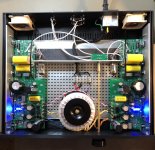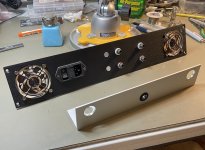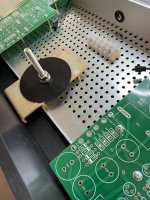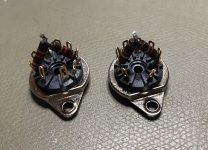I finally managed to close the projects of my “WOTS LeGrand” and “WOTS Tre” line pre-amplifiers.
Two very well-functioning pre-amplifiers, necessary for the optimal definition of the sound, before sending it to the power amps. Or two useless and boring post-amplifiers, according to the opinion of some of the readers.
Both are dual-mono builds and have the same warm and precise sound, even if they use different technologies: the LeGrand is hybrid (tube/transistor), and the Tre is completely solid state.
The electronic part uses symmetrically designed double-sided PCBs, a single PCB design serves both left/right channels depending on which side is used.
Since they have no loop feedback, good-quality components must be used.
I want to express my thanks to:
Two very well-functioning pre-amplifiers, necessary for the optimal definition of the sound, before sending it to the power amps. Or two useless and boring post-amplifiers, according to the opinion of some of the readers.
Both are dual-mono builds and have the same warm and precise sound, even if they use different technologies: the LeGrand is hybrid (tube/transistor), and the Tre is completely solid state.
The electronic part uses symmetrically designed double-sided PCBs, a single PCB design serves both left/right channels depending on which side is used.
Since they have no loop feedback, good-quality components must be used.
I want to express my thanks to:
- JLCPCB for the excellent service in the realization of PCBs;
- HiFi2000 for excellent cabinets.
Attachments
-
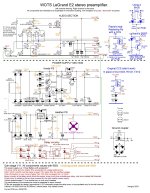 00 WOTS LeGrand E2 Schematic.jpg462 KB · Views: 984
00 WOTS LeGrand E2 Schematic.jpg462 KB · Views: 984 -
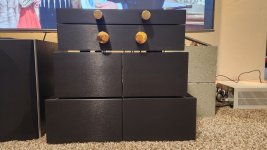 22 WOTS Tre and LeGrand on top of WHA-53.jpg395.5 KB · Views: 924
22 WOTS Tre and LeGrand on top of WHA-53.jpg395.5 KB · Views: 924 -
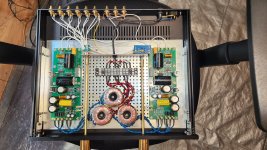 01 WOTS Tre E2 final assembly.jpg497.4 KB · Views: 751
01 WOTS Tre E2 final assembly.jpg497.4 KB · Views: 751 -
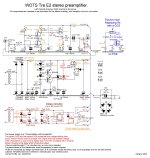 00 WOTS Tre E2 Schematic.jpg540.9 KB · Views: 806
00 WOTS Tre E2 Schematic.jpg540.9 KB · Views: 806 -
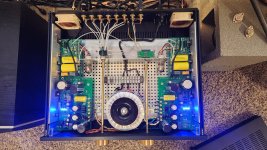 03 Final Assembly.jpg599.3 KB · Views: 744
03 Final Assembly.jpg599.3 KB · Views: 744 -
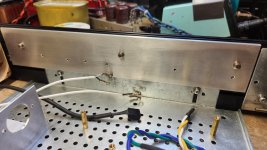 02 Ready to receive the PCBs 2.jpg346.5 KB · Views: 511
02 Ready to receive the PCBs 2.jpg346.5 KB · Views: 511 -
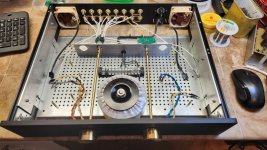 01 Ready to receive the PCBs 1.jpg439.8 KB · Views: 904
01 Ready to receive the PCBs 1.jpg439.8 KB · Views: 904
BF245 is obsolete too, and do not try to buy them on eBay, you will get some other JFETs with the correct stamp, but they are another thing inside; on the worst you get BJTs. I drew another PCB in order to accommodate the LSK489 B type, having more or less the same low transconductance and currents. This new PCB can be used with any JFETs. The only thing to adjust will be the lower source and upper drain resistors in order to have around 2V on the source and 30V on the drain, very easy to do. I must say honestly that I closed mine with the BF244C on the bottom and BF244B on top and didn't try the new PCB, or other JFETs, but I'm pretty sure they will work well.
Yesterday I completed my build of the WOTS LeGrand E2. Finished quickly in a couple of evenings... ha, not quite.. I took things slow and enjoyed the process. This patience seems to have paid off, the preamp worked perfectly from first power-up. Fabrizio is a very friendly, knowledgeable, and passionate diy'er that has obviously put significant time and effort into the development of the LeGrand. It shows in the mature clever PCB design and support documentation that he provided when I inquired about the project. He was always on hand to answer my questions and offer advice along the way. That said, I probably wouldn't recommend this beast to a novice builder.
I'll refrain from making any subjective sound comments as that always seems to generate some angst. Suffice to say, the unwritten rule says the latest audio project you've completed is always the best one yet, and probably the best that's ever been (in the history of all mankind, of course).. LeGrand has lots of gain and a beefy output stage, so I plan to try something later with my monoblock amps to use that to my advantage. So here's a finished top down view and a few other detail shots from along the way. The attenuator I used is one of those cheap DACT knockoffs (50K D-shape shaft version, from HK) found on the big auction site.
LeGrand has lots of gain and a beefy output stage, so I plan to try something later with my monoblock amps to use that to my advantage. So here's a finished top down view and a few other detail shots from along the way. The attenuator I used is one of those cheap DACT knockoffs (50K D-shape shaft version, from HK) found on the big auction site.
I'll refrain from making any subjective sound comments as that always seems to generate some angst. Suffice to say, the unwritten rule says the latest audio project you've completed is always the best one yet, and probably the best that's ever been (in the history of all mankind, of course)..
 LeGrand has lots of gain and a beefy output stage, so I plan to try something later with my monoblock amps to use that to my advantage. So here's a finished top down view and a few other detail shots from along the way. The attenuator I used is one of those cheap DACT knockoffs (50K D-shape shaft version, from HK) found on the big auction site.
LeGrand has lots of gain and a beefy output stage, so I plan to try something later with my monoblock amps to use that to my advantage. So here's a finished top down view and a few other detail shots from along the way. The attenuator I used is one of those cheap DACT knockoffs (50K D-shape shaft version, from HK) found on the big auction site.Attachments
I finally managed to close the projects of my “WOTS LeGrand”
If i may ask: why parallel tubes? Noise is hardly a consideration in a line stage and the output impedance is not dependent on the tube part anyway.
Incidentally, my current preamp is quite similar in topology, but with a DHT and a ccs in place of both plate and cathode loads.
And "WOT" in the context of tube preamps usually means "With Output Transforner"
@william2001: Good job!!! I hope it sounds well!
@analog_sa: Parallel tubes: no particular reason, I had some 6922 and want to build a dual mono preamp. I had a bad experience using a CCS as a plate load, I told myself never again. But I'm studying on a mu-follower, will see. Its load line is really interesting! Now I have to choose the best tube, I stopped on the 6SN7 unless better hints. I would like to limit the Vb to 240V, which enables a 2U cabinet. But this is an impossible thing with the 6SN7. However, about the LeGrand, the difference in the source follower using an R or a CCS is audible, hard to say which one is the best. This preamp belongs to the line named WOTS (Warmth Of The Sound), an S more, nothing to do with signal transformer.
@analog_sa: Parallel tubes: no particular reason, I had some 6922 and want to build a dual mono preamp. I had a bad experience using a CCS as a plate load, I told myself never again. But I'm studying on a mu-follower, will see. Its load line is really interesting! Now I have to choose the best tube, I stopped on the 6SN7 unless better hints. I would like to limit the Vb to 240V, which enables a 2U cabinet. But this is an impossible thing with the 6SN7. However, about the LeGrand, the difference in the source follower using an R or a CCS is audible, hard to say which one is the best. This preamp belongs to the line named WOTS (Warmth Of The Sound), an S more, nothing to do with signal transformer.
Before you forumers like this, please take a look at this:
https://www.diyaudio.com/community/threads/warmth-of-the-sound-wots.380373/
There are lots of professors explaining that an amplification stage must have no distortion at all. They have the recipe, but they do not recount it to us! Distortion is like watching Monnalisa with sunglasses. You better look at Monnalisa without sunglasses! The absence of distortion is a secret of theirs. A sort of Arabian Phoenix. I put a lot of effort into studying the tubes load lines, but it wasn't enough to find a working point without distortion. Evidently, the solution lies elsewhere and they know it. I know a good solution: no amplifier (no sunglasses), no distortion! Surpisingly none of those professors listened to a WOTS.
This design sports a bad distortion trend: it is the monotonically falling harmonic distortion: 2nd 0.71%, 3rd 0.15%, 4th not found. So, if you want to hear the music without any distortion, you better look elsewhere.
https://www.diyaudio.com/community/threads/warmth-of-the-sound-wots.380373/
There are lots of professors explaining that an amplification stage must have no distortion at all. They have the recipe, but they do not recount it to us! Distortion is like watching Monnalisa with sunglasses. You better look at Monnalisa without sunglasses! The absence of distortion is a secret of theirs. A sort of Arabian Phoenix. I put a lot of effort into studying the tubes load lines, but it wasn't enough to find a working point without distortion. Evidently, the solution lies elsewhere and they know it. I know a good solution: no amplifier (no sunglasses), no distortion! Surpisingly none of those professors listened to a WOTS.
This design sports a bad distortion trend: it is the monotonically falling harmonic distortion: 2nd 0.71%, 3rd 0.15%, 4th not found. So, if you want to hear the music without any distortion, you better look elsewhere.
the difference in the source follower using an R or a CCS is audible, hard to say which one is the best.
Not all CCS sound the same either. Having disliked the popular DN2540 and 10M45S for years i eventually came to a J309/IXTP01N100D cascode. Nothing new here, it just seems to work better for me musically.
0.7% second is not something i am prepared to live with in a preamp. An order of magnitude better is easily achievable with tubes.
When you apply a CCS on a plate, you must be very careful in designing the PCB because of parasitic capacities, it is a matter of pF. The bandpass is highly affected depending on track routing. Your CCS sounds to be around 5mA, with very high impedance, so the track routing matters a lot! This was my bad experience (8KHz on a gain stage), perhaps a better routing of the tracks would have solved the issue. Did you try a cascode CCS made out of BJTs?
A possible solution to the distortion with fewer problems about parasitic capacities would be a mu-follower, and the 2nd will drop a lot (0.11% - 0.02 3rd with the 6922). However, 0.7% is absolutely acceptable when the 3rd is steep lower. The CJ GAT ($24K) sports a 0.15% distortion, which is only 4.7 times less, I believe it is not reasonably possible to go lower. I would like to see its schematic, but no luck.
A possible solution to the distortion with fewer problems about parasitic capacities would be a mu-follower, and the 2nd will drop a lot (0.11% - 0.02 3rd with the 6922). However, 0.7% is absolutely acceptable when the 3rd is steep lower. The CJ GAT ($24K) sports a 0.15% distortion, which is only 4.7 times less, I believe it is not reasonably possible to go lower. I would like to see its schematic, but no luck.
@analog_sa I forgot to say 0.71% is at 15Vrms, at 3Vrms 2nd is 0.14%, 3rd is 0.01%
I've thought about this a little...and I wonder if this guy is onto something at #77 here..There are lots of professors explaining that an amplification stage must have no distortion at all....
https://www.diyaudio.com/community/threads/tube-system-for-symphony-jazz.270210/page-4#post-4243881
So if these harmonics, or whatever it is, are lost as soon as they hit the microphone(s), and then never restored (perhaps some carefully, and properly implemented thermionic emission in the chain WILL restore it to some extent, maybe this is the "magic"?).... then that means the super duper low dot-million-zeroes-distortion straight-wire-with-gain path is actually more "distorted" when you really think about it, if the illusion presented actually sounds less like real voices / real musicians playing real instruments in a 3D space out in front of you. That system reproduced the lost information.. wait for it.... "perfectly"
I don't understand why a mosfet follower is used after 2 6dj8 in parallel, especially when driving the output through only 10uF capacitor...it can't drive less than a 2...5 kohm load through a 10uF cap with a reasonable bandwidth which 2 x 6dj8 in parallel can handle by themselves easily and even with good sounding distortion patterns which the use of a mosfet will simply destroy.One single 6dj8 followed by a mosfet can drive 32 ohms headphones easily...
I don't understand why a mosfet follower is used after 2 6dj8 in parallel, especially when driving the output through only 10uF capacitor...it can't drive less than a 2...5 kohm load through a 10uF cap with a reasonable bandwidth which 2 x 6dj8 in parallel can handle by themselves easily and even with good sounding distortion patterns which the use of a mosfet will simply destroy.One single 6dj8 followed by a mosfet can drive 32 ohms headphones easily...
The mosfet follower will provide a much lower output impedance than the parallel 6dj8. It will not destroy any "good sounding distortion patterns" as it adds negligible distortion compared to the 6Dj8.
You may still dislike the resultant sound but the reason will not be the added distortion. You may also not need the low output impedance.
The use of parallel tubes is explained in #9
Last edited:
The lack of distortions is the one that I don't like in using expensive current hungry tubes...besides much lower distortions can be obtained from ccs or mu followers so if someone is to use a mosfet with 6dj8, the most natural choice is the use of Allan Kimmel's mu-follower that gets you everything in one go: lower distortion, low enough impedance and very high PSRR, making the use of that fancy mosfet voltage regulator useless.
marigno has a mu-follower in the works, part of an updated suite of preamps (LeGrand won't change much). It's been a little while and I can't find the e-mail at the moment, but I believe he told me LeGrand is still ahead of his mu-follower sonically, but things are not finalized yet.
Tubes restoring harmonic content... It would be a great synergy. In some issues of the Italian CHF magazine, there is an article by F. Chiappetta dealing with a "Harmonizer", which adds some 2nd to the signal; if I well remember it uses a 12AX7 with extremely low current bias.
LeGrand is a preamp showing a distortion like any other simple SE triode stage with an optimized loadline without a CCS. Its monotonically falling distortion is euphonic.
Too bad!!!
Sure there are better designs, one of them I come to know is the "Truth", a distortionless gain stage that some hard-skilled forumers seem to particularly appreciate.
LeGrand E2 will remain the one shown in this thread, with CCS and no LEDs. I trashed all the mods I was studying because they didn't lead to any real improvement.
I will re-open the Tre project because it uses obsolete JFETs, impossible to find. I'm going to use the LSK489. We'll see.
I'm working on a mu-follower with a friend of mine, who is running late. Sure I wish to avoid ending up to some other Aikido with different clothing.
LeGrand is a preamp showing a distortion like any other simple SE triode stage with an optimized loadline without a CCS. Its monotonically falling distortion is euphonic.
Too bad!!!
Sure there are better designs, one of them I come to know is the "Truth", a distortionless gain stage that some hard-skilled forumers seem to particularly appreciate.
LeGrand E2 will remain the one shown in this thread, with CCS and no LEDs. I trashed all the mods I was studying because they didn't lead to any real improvement.
I will re-open the Tre project because it uses obsolete JFETs, impossible to find. I'm going to use the LSK489. We'll see.
I'm working on a mu-follower with a friend of mine, who is running late. Sure I wish to avoid ending up to some other Aikido with different clothing.
- Home
- Source & Line
- Analog Line Level
- WOTS Pre-amplifiers
